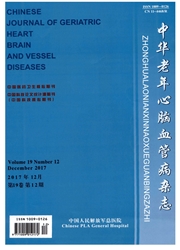

 中文摘要:
中文摘要:
目的 探讨心肺耦合技术中呼吸紊乱指数(RDI)与多导睡眠图(PSG)监测参数之间的相关关系,并分析心肺耦合-RDI与PSG-呼吸暂停低通气指数(AHI)两种技术对睡眠呼吸事件判读的一致性.方法 收集于2016年1-12月就诊于第二军医大学附属长征医院睡眠障碍诊疗中心监测的患者292例,根据PSG中AHI是否大于5次/h将病例分为两组:AHI〉5次/h为阻塞性睡眠呼吸暂停低通气综合征(OSAHS)组,共173例;AHI〈5次/h为非OSAHS组,共119例.比较两组之间PSG睡眠参数和心肺耦合-RDI的差异,采用Pearson相关分析方法分析呼吸紊乱指数心肺耦合-RDI和PSG各参数的相关关系,用Bland-Altman图检验两种方法的一致性,并应用受试者工作特征曲线分析心肺耦合-RDI对OSAHS的诊断价值.结果 与非OSAHS组相比,OSAHS组在总睡眠时间[(445.94±82.64)min]、呼吸暂停次数[(108.16±35.70)次/h]、低通气次数[(55.62±17.44)次/h]、AHI[(22.78±20.73)次/h]、埃普沃思思睡量表(ESS)得分[(11.21±5.30)分]、心肺耦合-RDI值[(32.98±22.19)次/h]等方面较对照组[(417.21±96.10) min,t=2.730;(7.89±5.41)次/h,t=30.384;(11.05±2.23)次/h, t=27.709;(5.51±3.11)次/h,t=9.014;(7.61±2.29)分,t=6.973;(11.16±8.63)次/h,t=10.205]均有增加(均P〈0.01),而在N1期潜伏期[(14.79±9.29) min]、N3期百分比[(6.53±4.95)%]、最低血氧饱和度[SaO2;77.91±12.21)%]等方面较对照组[(18.18±8.98) min,t=-3.106;(8.83±7.29)%,t=-3.212;(92.72±5.17)%, t=-12.479]均有减少(均P〈0.05).Pearson相关分析结果显示,心肺耦合-RDI与总睡眠时间、N2期睡眠时间、N3期睡眠时间、呼吸暂停次数、低通气次数、AHI、微觉醒次数及指数、腿动次数及指数、呼吸相关腿动次数、微觉醒相关腿动次数、周期性腿动次数及指数、ESS得分等参数之间呈正相关,其中,心肺耦合-RDI与PSG-AHI之间相关关系最强(r=0.8
 英文摘要:
英文摘要:
Objective To explore the relationship between the respiratory disturbance index (RDI) detected by cardiopulmonary coupling (CPC) and all parameters of polysomnography (PSG), and to analyze the correlation of the two different analytical techniques for the interpretation of sleep breathing events.Methods In this case-control study, the patients/ CPC and PSG were simultaneously recorded at the Sleep Clinic at Changzheng Hospital from Janunary 2016 to December 2016.Effective recordings were obtained from 292 patients (male/female: 173/119).According to PSG, these patients were divided into two groups: obstructive sleep apnea hyponea syndrome (OSAHS) group (n=173, aged (50.1±13.3) years) and non-OSAHS group (n=119, aged (50.5±11.7) years).All the PSG parameters and the RDI detected by CPC were compared between the two groups.Pearson correlation was used to analyze the relationship between the CPC-RDI and polysomnography parameters, and Bland-Altman chart was used to test the correlation of the two methods.The receiver operator characteristic curve was used to research the value of CPC-RDI in diagnosis of OSAHS.Results The OSAHS group showed higher levels of total sleep time (TST, (445.94±82.64) min), apnea times ((108.16±35.70)/h), hypopnea rate ((55.62±17.44)/h), apnea hyponea index (AHI, (22.78±20.73)/h), Epworth Sleeping Scale (ESS) scores ((11.21±5.30) scores), CPC-RDI ((32.98±22.19)/h) compared with the non-OSAHS group ((417.21±96.10) min,t=2.730;(7.89±5.41)/h,t=30.384;(11.05±2.23)/h, t=27.709;(5.51±3.11)/h,t=9.014;(7.61±2.29)scores,t=6.973;(11.16±8.63)/h,t=10.205, all P〈0.01), and a significant decrease in N1 latency ((14.79±9.29) min vs (18.18±8.98)min, t=-3.106), N3% ((6.53±4.95)% vs(8.83±7.29)%,t=-3.212) and the lowest oxygen saturation (SaO2;(77.91±12.21)% vs(92.72±5.17)%, t=-12.479, all P〈0.05 respectively).Pearson correlation an
 同期刊论文项目
同期刊论文项目
 同项目期刊论文
同项目期刊论文
 Risk Factors Associated with Sleep Disturbance following Traumatic Brain Injury: Clinical Findings a
Risk Factors Associated with Sleep Disturbance following Traumatic Brain Injury: Clinical Findings a Correlation between Endothelial Dysfunction, Rho-associated Protein Kinase Activity, C-reactive Prot
Correlation between Endothelial Dysfunction, Rho-associated Protein Kinase Activity, C-reactive Prot Modafinil treatment prevents REM sleep deprivation-induced brain function impairment by increasing M
Modafinil treatment prevents REM sleep deprivation-induced brain function impairment by increasing M 期刊信息
期刊信息
